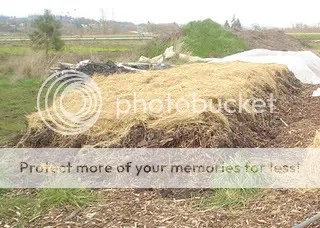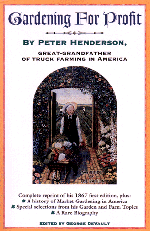Farming’s still on hold until I get life straightened out. New expenses mean more time spent on off-farm work, so I’m going to have to approach my farming goals weekend-warrior style. Plus, I’m looking after my 12 year old nephew, which takes up a lot of my free time. Lots of stuff still going on! I’ll tune back in soon.
Update: Change o’plans!
I’m currently revisiting my farming plans and tweaking them based on my new location and new circumstances. There’s some clarification in the newsletter, which I just sent out a few days ago. More details to follow!
Update: New site design
If you head on over to the home page, you’ll see a new design up. I simplified the organization, too. I originally created the site with the intention of adding articles and book reviews periodically, but there’s not much time for that now. If you have any suggestions or feedback, please share! Thanks!
Profits to be made, but how?
In one of the listservs I’m signed up for, someone recently posted a link to an Ohio State University research project that strives to prove you can make $90,000 per acre with polyculture (i.e. making neighbors of fruits and vegetables). People were quick to respond that the figures shouldn’t be misinterpreted–the $90k cited in the study doesn’t account for labor costs, among other things, such as time and money spent marketing and actually selling the stuff.
There are a lot of people I’ve met, or read, who hold onto the idea that a farm can become more profitable by intensifying production on a small plot. So far, though, my personal observations and research points to the opposite conclusion. It may not be as romantic as tending to a small plot with your own two hands, but romance can get pretty expensive. Here is what I posted on the listserv:
When I visited Eliot Coleman a few years ago, he was grossing $150k from 1.5 acres. He was also quick to note that after all the staff got paid and some of the costs were accounted for, all that was left over was $20k. Also keep in mind that there are some things he doesn’t have to pay for from the farm income that most of us would, such as his land, which was practically given to him by the Nearings, or his house, which is probably funded by income from other sources (e.g. royalties) and that of his wife, and all the associated utilities (probably part of the house bill). Likewise, equipment may have been purchased through other income sources, so it’s quite possible that if you looked at true costs, he might be operating at a loss.
When I look at the previously mentioned publication, Grower to Grower (big PDF link), or other case studies like Bear Creek Farms and Groundwork Organic Farm, the pattern for profit seems to be increasing scale and selling wholesale (i.e. selling in bulk to a middleman). A CSA can also be an income stabilizer, but only if it’s a large CSA (100 members) because otherwise, the income it generates doesn’t seem to cover the additional cost of management (organizing shares, marketing, sorting, sending staff to pick-up sites, etc.). Those are just my own observations after reading about and working on a variety of farms, with the question being how a farmer can earn a full-time income from a farm. It definitely seems do-able, if you play your cards right.
Henderson on Hotbeds
Notes based on Gardening for Profit (Chapter 9) by Peter Henderson.
Hotbeds are something we don’t see a lot of, despite their simplicity and usefulness. The idea is that compost generates heat, and seeds need heat to germinate. So why not put seeds directly on the compost pile (the “hot bed”) and coax those little buggers into making their debut a little early in the season? Henderson was doing this in the 1800s, and the logic still applies today:

This is a freshly made hotbed at Singing Pig Farm. It’s about 2 feet tall, 8 feet wide, and 40 feet long. (Disclaimer: I’m terrible at judging dimensions, so give or take about 20 feet on the width and length.) It’s topped with a layer of straw to level the surface and provide additional insulation. Under the straw is a rotting pile of leaves and grass clippings, courtesy of a landscaping company that was happy to get rid of it. The temperature in the pile when it was formed was 105 degrees Fahrenheit. Read the rest of this entry »
6 Rules of Biological Farming
Today I actually found the time to read. Gardening for Profit is buried somewhere in the moving boxes, but I did manage to bring along my copy of The Biological Farmer. I’ll finish posting notes for Gardening for Profit when I get back to Oregon, but now seems like a good time to start sharing what I’m learning from Gary Zimmer.
This author runs a sustainable agriculture consulting firm in the upper Midwest and this book was originally intended to be a primer for consultants-in-training. He also owns and operates a 500-acre organic crop and dairy farm, and manages a 240-acre livestock and crop demonstration farm. It sounds like he’s heavily influenced by Albrecht, so I’m using this book as an introduction to soil-focused agriculture.
Some of the information isn’t new to me, since I studied environmental science and ecology in school. My eyes didn’t perk up till chapter 2, when he described 6 rules essential to biological farming. By “biological” farming, he means farming to maximize productivity and profits over time by understanding and working with biological processes (whereas conventional practices focus on maximum productivity and profits ASAP, and don’t give a @#$% about biological processes). He goes a step further and describes his criteria for sustainable agriculture, which can be achieved by practicing biological agriculture properly and in the long run: zero soil loss, nutrient balance, and 25 earthworms per cubic foot of soil.
So here are the 6 basic rules essential to biological farming: Read the rest of this entry »
Update: Life on Hold
So I made it out to Oregon safe and sound. It was stressful and exhilarating and exhausting all at once. This was my second cross-country move, and hopefully my last.
In the middle of my trip I got one of those dreaded middle-of-the-night phone calls that my mom is in the hospital. This is a repeat of the medical emergency that I posted about in December. Less than 48 hours after arriving at my new home, I was on a plane back to the Southwest to be with my mom. In fact, I’m writing this from an airport in Phoenix while I wait for my connecting flight. I’ll post again once I return to Oregon.
Update: Moving to Oregon
I might not be posting as much over the next few weeks because I’m making a cross-country trek from New Mexico to Oregon. Here’s why:
- I came to NM from NY just over a year ago because my boyfriend was going to grad school at New Mexico State Univ. He just finished, so we have the option of relocating.
- While I love NM in more ways than one (the friendliness, the culture, the live-and-let-live attitude, the striking landscape, the low cost of living) I don’t want to spend the rest of my farming career squabbling over water rights so that more and more people can fill their swimming pools and water their lawns in the desert.
- I miss trees. And the sound of a river running. And distinct seasons. Plus I have some cozy winter coats that are going to turn into moth food if I don’t use them.
- Job prospects are not so great here for either of us. The Pacific Northwest has a lot more going on in terms of agriculture (more opportunities for me) and the three largest cities are quite close together (more opportunities for him), making it more likely that we can both pursue careers while still living together.
- Cost of living in Oregon is reasonable. We found a two-bedroom apartment in a relatively new, well-kept complex in Salem for $550 per month. Private health insurance is affordable as well.
- Returning to the East coast doesn’t attract either of us. After living out West, the “other side” seems too crowded, expensive, and rigid (versus dynamic, growing, taking shape). We feel we have a better chance of achieving our goals out here.
The runner up was Missouri. But Oregon won out, perhaps because of the diverse landscape (mountains, ocean, and desert) or Portland’s awesome food scene or the lure of the temperate rainforest up in Washington. Who knows? Oregon, here I come.
Henderson on Sh—uh, Manures
Notes based on Gardening for Profit (Chapter 7) by Peter Henderson.
Back then when horses did all the work, there was lots of horse manure to be had. So Henderson took advantage of it and really piled it on.
At least six months before applying it, the manure was dumped in a natural depression. If there wasn’t one, they dug one out 18-24″ deep. They put up a 6′ fence around it. The wagons were pulled up next to the fence and fresh manure was tossed in, spread out evenly throughout the depression. Pigs were kept in the enclosure to break things up, and they were fed weeds and unsold vegetables from the field.
- I wonder how large this manure pit needed to be. I guess it depends on how much manure he needed, which depends on how much land he was preparing (he’d spread 50 to 100 tons per acre).
- Also, how many pigs? Two? Ten? That’s probably a function of field size and manure quantity, as well.
Henderson was a big fan of horse manure, and not just because it was plentiful. He considered it 1/3 more valuable than that of cattle and pigs, in terms of weight (i.e. 100 lbs of horse manure would work just as well as 130 lbs of cattle or pig manure). He also cites horse manure as being extra beneficial as a pulverizer on stiff soils. Read the rest of this entry »
Henderson on Soil Preparation
Notes based on Gardening for Profit (Chapter 6) by Peter Henderson.
Henderson describes the soils he works with. His general guideline is to look for a dark-colored loam soil (neither sandy nor clayey) that’s at least 12″ deep, preferably with a yellowish sandy loam underneath (good for drainage). Soils to look for, in order of preference:
1. alluvial saline deposit – usually within a mile from the tide mark; dark heavy loam containing decomposing shells; 10-30″ deep; overlaying subsoil of yellow sandy loam
2. lighter soil, both in color and specific gravity – 8-15″ deep; similar subsoil to above
3. still lighter soil, in color and specific gravity – sand predominates over loam; subsoil is pure sand; good for melons, cucumbers, sweet potatoes, radishes, and tomatoes; not good for onions, cabbages, celery
4. clayey loam – 10″ deep; over thick stratum of stiff bluish clay; found on highest points; not good for early vegetables; favorable for a late crop like celery
Note to self: Look further into soil classification. I’m having trouble visualizing these distinctions because I’ve never closely analyzed soils. Read the rest of this entry »

 Back to home page
Back to home page

 Save this page on Del.icio.us
Save this page on Del.icio.us